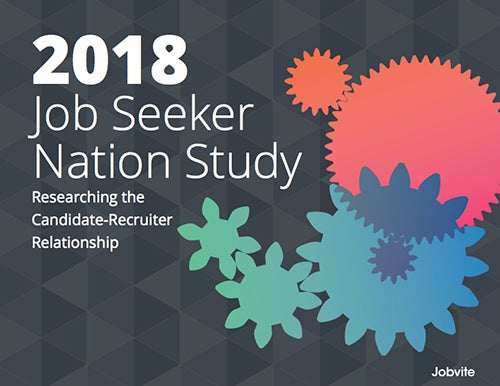Announcing Job Seeker Nation 2018: Exploring the Candidate-Recruiter Relationship
 It’s 2018, and the American workplace is in flux. The economics have shifted, and for the first time in a long time, nearly every qualified candidate is employed. New technologies such as artificial intelligence and automation are transforming entire industries, including talent acquisition, forever. A new generation has entered the workforce, alongside ground-breaking new movements focused on racial and gender inequality.
It’s 2018, and the American workplace is in flux. The economics have shifted, and for the first time in a long time, nearly every qualified candidate is employed. New technologies such as artificial intelligence and automation are transforming entire industries, including talent acquisition, forever. A new generation has entered the workforce, alongside ground-breaking new movements focused on racial and gender inequality.
As the dust settled from a year devoted to upending the status quo, we surveyed over 1,500 workers on the American work experience to unearth a new truth: the rules around recruiting and hiring have evolved. The relationship between job seekers and recruiters has changed, and the hiring process is no longer a linear start-to-finish. Rather, recruiting top talent requires a continuous cycle of engagement.
Candidates today expect a more seamless experience, where brand, culture and personal connection fit together cohesively. For companies, that means administrative efficiency, recruiter-first processes. Transactional relationships just won’t cut it anymore. Today’s candidate-recruiter relationship must take into account the job seeker journey, and both parties will be forced to adapt to find success in this new era.
In our annual Job Seeker Nation Report, Jobvite examined the new dynamic between employers and candidates, the growing expectations for both sides, and what a successful hiring journey looks like. Some key findings include:
- Job seekers are on the move:
- Job hopping is more common than ever: an increasing number of job seekers (51%) still claim to change jobs every 1-5 years — compared to 42% last year and 34% in 2016.
- Job hopping is becoming less common among younger workers, though, and more common among older workers: 38% of younger workers anticipate holding 1-3 jobs throughout their lifetimes (compared to 28% of older workers) — while 22% of older workers assume they’ll hold 7-9 jobs (compared to just 14% of younger workers).
- Job searching 101 — how are job seekers finding jobs today?
- When looking for a job, don’t be afraid to tap into your network: 60% of job seekers have referred a friend or contact to a company they’ve worked for — and 35% of job seekers obtained their current or most recent job from a referral.
- Keep your LinkedIn up to date! Almost a quarter of job seekers applied to their current or most recent job via LinkedIn.
- Should they stay or should they go? Here’s what today’s employees consider before jumping ship:
- No surprise – compensation was the #1 factor for leaving a job in the last year (19% of job seekers) — with a lack of growth opportunities coming in as a close second, especially among younger workers at 13%
- Almost a quarter (22%) of respondents have preemptively rejected a potential employer due to reviews on Glassdoor and other public company reviews – especially younger workers (31%) compared to older (14%).
- A signature is not a done deal:
- Almost 30% of job seekers have left a job within the first 90 days of starting. Why?
- 43% cite that their day-to-day role wasn’t what they expected.
- 34% report an incident or bad experience drove them away.
- 32% call out company culture as a reason for leaving within the first three months
- 11% of them have changed their minds on an offer after signing — most often because they received a better offer (60%).
- Culture is make or break — even before the first day:
- The vast majority of job seekers (88%) cite culture as at least relatively important in applying to a company — and 46% claim it’s very important
- Nearly a third of them (32%) would even be willing to take a 10% pay cut for a job they’re more interested in or passionate about.
- For those job seekers that have turned down a job offer, 15% cite company culture as the main reason why.
To read more about Americans’ changing expectations in the workplace, download this year’s Job Seeker Nation Report in its entirety. The report was conducted by Zogby Analytics and surveyed over 1,500 U.S. adults.
And keep an eye out for more as we delve into the real truth behind job seekers’ experiences with sexual harassment and bullying in the American workplace coming soon!